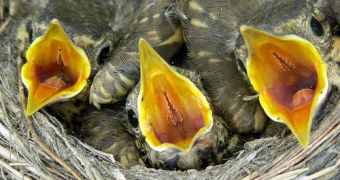Even though it may seem very difficult for a chick in a big colony to get noticed by its parents, new research concluded that when baby birds are hungry, they have individual ways of calling their parents and letting them know.
German and Swiss ornithologists carried out a research studying the calls of chicks in a population of Jackson's golden-backed weaver birds on the shores of Lake Baringo in Kenya, and found that being a small chick in a big colony can sometimes be difficult, but never when it comes to food.
Researchers already knew that parent birds can make the difference between their own chicks and others, by the unique pattern changes in the frequency of their call.
So now, they wandered whether the parents could also tell when their chicks were hungry, and just how hungry they were.
To find out, they temporarily removed chicks from their nests, and set up cameras and microphones to record the chicks' behavior and begging calls.
“Weaver bird chicks have two parts to their call – a 'whistle-like' call followed by a 'trill-like' call,” explained lead researcher Hendrik Reers said.
“In a non-hungry state, these parts of the call are slightly different from bird to bird, and this allows the mother to identify their chicks.
“As the chicks get hungrier, as you might expect with any baby, the call gets louder and more energetic, but each bird still has a unique way of modifying their 'normal' call to an 'I'm hungry' call.
“These results imply that parents have to be familiar with their chicks' begging calls in order to estimate their hunger precisely.”
The ornithologists concluded that the weaver bird chicks changed the length, pitch and amplitude of their calls, by adding extra trills and by shortening whistles, and the hungrier a chick got, the more different its call became.
This research is published today, January 26, 2011, in BioMed Central's open access journal BMC Ecology.

 14 DAY TRIAL //
14 DAY TRIAL //